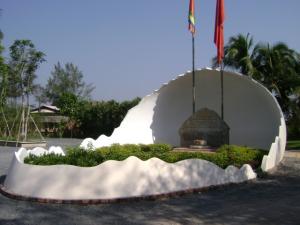Passage to Vietnam

Mot Thoang Viet Nam or Passage to Vietnam Crafts Village in Cu Chi District, 55 kilometers from ${bigcity_Ho_Chi_Minh_City:"Ho Chi Minh City"}, is a haven of Vietnamese history, traditional trades and architecture. With its 22.5 hectare area, it’s a big and sufficient venue for visitors to grasp enough information and even understanding about the country.
The entrance to the place is a large egg, a symbol of where and how Vietnam began. According to legend, the Vietnamese are the descendants of the Hung Kings. The first Vietnamese descendant was said to be the eldest son of a dragon named Lan Loc Quan, and a fairy named Au Co. The couple was said to have 100 children who were all born from eggs.
After the entrance is a long corridor decorated with photos and exhibits from thousands of years ago. An exhibit named “A Return to the Roots” displays several items: The Dong Son bronze drums are a cultural symbol of the Bronze Age Dong Son culture dating back 2,000 BCE – 200 CE. There is a phoenix head of the Dinh Dynasty 986 – 980 CE. A bronze string instrument almost 2,000 years old is also among the highlights of the exhibit.
The 65 provinces and cities of Vietnam are each represented by huge maps along with its mountains, rivers, national parks and other important features. Moreover, a 70-meter long map floats on water wherein each province and city of the country is made of soil collected from its corresponding area.
The Xa Tac altar, Xa Tac meaning “nation,” is another historical highlight in the crafts village. Vietnam history dictates that kings performed ceremonies at the altar to pray for their country and people. The Xa Tac altar is made of earth and water from all over Vietnam to represent the nation. Three stakes are placed next to it, just a few among the hundreds that kings and generals set up in the Bach Dang River in the northern province of Quang Ninh to guard against foreign enemies in 938, 981 and 1288. Tourists can burn incense sticks at the altar. On special occasions like the 15th day of the lunar month, 100 drum rolls are sounded to represent calling to the mountains and rivers, the souls of dead people, and showing respect to the ancestors.
Mot Thoang Viet Nam also has a showcase of models of traditional houses from the different regions of the country: north, center, south, and highlands. Houses in the central province of Binh Dinh in particular are considered “intelligent” because of the clay-straw walls and roofs that are designed to be cool in the summer, warm in winter, and even fire-resistant.
The H’Mong people’s houses on the other hand are made of the rare wood Fujian cypress, which has a particular pleasant scent and drives insects away. The roof is composed of several removable planks to let sunlight in. Bana and Muong houses are made of stilts, while the houses of the Ede people are long.
The trade village is one of the main attractions of Mot Thoang Viet Nam, showcasing 12 traditional crafts from different regions. Weaving, carpentry, sculpture are some of the crafts displayed, including do, a traditional paper made from the bark of the tree Rhamnoneuron Balansae, a native of the north. Visitors can also try their hands on these crafts, even spend several days with the artisans to learn how to make souvenirs by and for themselves.
The herb garden is a collection of plants from the hard-to-find wood kim giao (Nageia fleuryi), which was used to make chopsticks for kings during the historical era. It was believed to detect poison by changing its color. 100 species of bamboo can also be found in the garden, bamboo being the symbol of Vietnam.
Aside from historical learning, tourists can also find entertainment and relaxation in the village with its Vietnamese-inspired resort, treating its guests to several activities like fishing, playing folk games, and watching cultural performances. Of course, visitors will have a chance to taste Vietnam food with specialties from different parts of the country.









